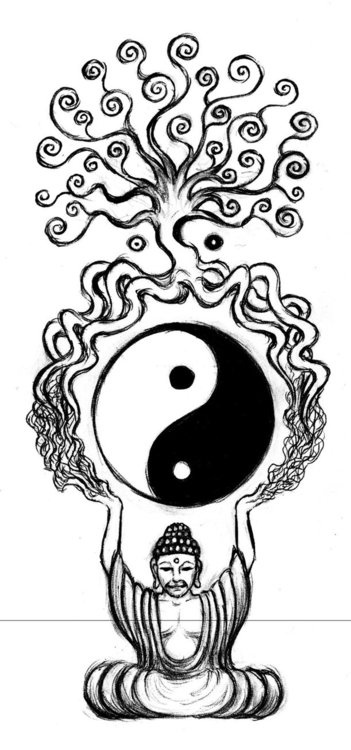“The heart of a human being is no different from the soul of heaven and earth. In your practice always keep in your thoughts the interaction of heaven and earth, water and fire, yin and yang.”
~ Morihei Ueshiba
So, why are you here? I mean really here ….
One school of thinking is that the purpose of life is to increase the level of consciousness which occurs through the interaction between your spirit self and your physical self or matter. And that we continually re-incarnate until such time as we learn the experience we are meant to learn.
Through experiencing and observing the different levels of duality, such is there is no up without down, you may come to understand that life is not a series of separate entities but a continuum around a common aspect of life.
The concept of duality is seen in Chinese philosophy as Yin and Yang: Where two opposing, but complementary, forces are described. Neither side can exist without the other; there are no absolutes. It is the tail and the head of a coin. The tail is yin, then the head is yang. They exist alongside one another. The head cannot exist without the tail, and the tail cannot exist without the head.
The symbol for Yin-Yang is represented as one side black, one side white, with a little opposing circle in each sphere. The dividing line shows that the two aspects are always merging. The small contrasting circles show the potential for transformation into the opposite force.
There is a twist or spiraling effect to the two spheres, which reflects the concept that balance is achieved through the unification of the two poles. Yin-Yang philosophy shows that it is impossible to stay in one aspect and ignore the other.
How does Yin-Yang theory relate to our concept of self-healing?
Our physical body is a truly amazing thing. Much of what goes on happens without our conscious act. This harmonic, balanced environment is known as homeostasis. The body does an excellent job at detecting imbalances at an early stage, and by fine tuning, correcting them without the problem being brought into conscious awareness.
However, when the influence of the mind overrules these adjustments, then the imbalance can reach a crisis point and disease is inevitable in order to recreate harmony. Take for example a business man (or woman!) who continues to burn the candle at both ends with an excess intake of alcohol, spices and coffee. To curb his excess, the body may develop an ulcer or something that will slow him down, maybe even a heart attack (or a shoulder going out of alignment!). The business man likely will find these physiological events to be a real inconvenience.
To a spiritual man, however, the resultant disease states – hopefully noticed early on and not ignored – will be looked upon as salvation. Ignore the need for change, and more permanent ways will likely become present to redress the imbalance.
Disease is often seen as a crisis in one’s life, and yet, the word “crisis” has it’s roots in the Greek word “decision”. Thus disease can be seen as a decision which needs to be made from one aspect of polarity which is being expressed in an extreme manner, and decide to instead, face, experience, and accept the other.
Disease should never be considered a punishment or a sign of weakness, but a natural process in the recreation of equilibrium.
This can be deduced into the law of Karma. This law states that all we put out will eventually return. Karma is not the punishment for wrongdoing. It is there to help us understand that both poles – Yin & Yang – exist and to mindfully and wisely choose to become neither, or the middle line.
I had an interesting experience yesterday, with a friend, as I watched her circling around in this theory. She had come to the realization that much of her life had been based upon fulfilling a certain need. In her attempt to correct this sway too far to one side, she was naturally drawn into the center of the polar opposite. I was working with her to find the middle line.
To quote the brilliant philosopher, Alan Watts:
“Sadly for most of us, when we realize the inseparability of the positive and negative poles of the rhythm, we respond …. Trying to keep the mountains and get rid of the valleys.”
The great psychologist, Carl Jung, called this unexpressed pole of duality the “shadow side”. By continually running from this aspect of ourselves that we refuse to acknowledge, we only create a greater shadow. Symbolically, there is no shadow if we stand directly under the sun. Through moving our awareness from the influence of the outer world, to that of the inner balanced soul world, we hopefully come to realize all as just passing phases of the same experience.
Here’s an exercise for you to ponder on today to help understand this theory:
1.) Choose 6 things you like about yourself. (ie. your caring nature, your laugh, etc.)
2.) Choose 6 things you DIS-like about yourself (ie. your irritability, your hips, etc.)
3.) Go stand in front of the mirror and re-affirm your good points: “I like the fact that I am …”
4.) Now affirm to yourself that the negative aspects are also a part of your total being: “I accept the fact that I am …”
5.) Look at the two lists and see if there are areas of contradiction.
The clue is to detect the common theme. To hate the negative aspects of self is to miss the point entirely. Both sides represent an area of imbalance.
As an example, say you listed: I am a caring (positive) … But I am intolerant (negative). The over-caring nature can mean inadequate time spent in receiving and too much time spent in giving, leading to an expression of the imbalance through feeling irritable, comfort eating and moodiness.
By finding time for self, and becoming aware of the areas where there is neglect, the “negative” aspects dissolve, while those that are “positive” come more into harmony. Always remembering that you cannot have one without the other. The key is to find the balance. No mountain exists without the valley.
“The Sage is he who is Forthright but not hurting; Sharp but not wounding, Candid but not being crude; Shining but not dazzling”.
~ Lao Tzu, Tao Te Ching



